Being a cat owner brings great joy and companionship. But keeping them healthy can be tricky. In this guide, I’ll share tips to keep your cat happy and healthy.
We’ll cover nutrition, preventive vet care, grooming, and behavior training. These strategies help with feline wellness. Whether you’re new or experienced, this article will help your cat live its best life.
Key Takeaways
- Unlock the secrets of cat nutrition and create a purr-fect meal plan
- Proactively approach preventive vet care to keep your cat in tip-top shape
- Develop effective grooming routines to minimize shedding and maintain a healthy coat
- Foster a well-mannered companion through positive behavior training
- Enrich your indoor cat’s environment to prevent boredom and stimulate their senses
Unlocking the Secrets of Cat Nutrition
Proper cat nutrition is key to your cat’s health and happiness. It’s important to know what they need and how to feed them right. We’ll look at the key nutrients and superfoods that help your cat stay healthy.
Decoding Feline Dietary Needs
Cats need a diet full of animal proteins because they are obligate carnivores. They use meat, poultry, and fish nutrients well. As a pet owner, pick top-quality cat nutrition products that fit your cat’s age, activity, and health.
| Nutrient | Importance for Cats |
|---|---|
| Protein | Supports muscle growth, maintenance, and repair. |
| Fatty Acids | Promote healthy skin and coat, as well as brain and heart function. |
| Vitamins and Minerals | Ensure proper bone, immune, and organ health. |
Superfoods for a Purr-fect Meal Plan
You can add superfoods to your cat’s diet, along with quality cat nutrition products. Great superfoods for cats include:
- Lean meats, such as chicken and turkey
- Fish, particularly oily varieties like salmon and tuna
- Eggs, a rich source of protein and essential vitamins
- Organ meats, like liver and heart, which are packed with nutrients
- Fruits and vegetables, such as blueberries, spinach, and sweet potatoes
Knowing your cat’s feline diet needs and adding these superfoods can make their meals better. This keeps your cat happy, healthy, and doing well.

Preventive Vet Care: A Proactive Approach
Regular check-ups and preventive care are key for your cat’s health. It’s important to build a strong bond with a trusted vet. This ensures your cat stays healthy. From vaccinations to parasite control, taking a proactive stance makes a big difference in your cat’s health.
Vaccines protect your cat from many infectious diseases. Your vet will suggest the right vaccination schedule for your cat’s needs. Keeping up with these vaccines is crucial for your pet’s health and safety.
Parasite control is vital for your cat’s health. Fleas, ticks, and internal parasites can harm your cat. Your vet can recommend treatments to keep these pests away and protect your cat.
- Routine check-ups: Regular vet visits help catch and manage health issues early.
- Dental care: Good dental hygiene prevents painful dental problems and keeps your cat healthy.
- Grooming support: Your vet can guide you on keeping your cat’s coat and nails healthy.
Putting preventive vet care first is a smart move for your cat’s health. This proactive approach saves on future costs and keeps your cat happy and healthy.
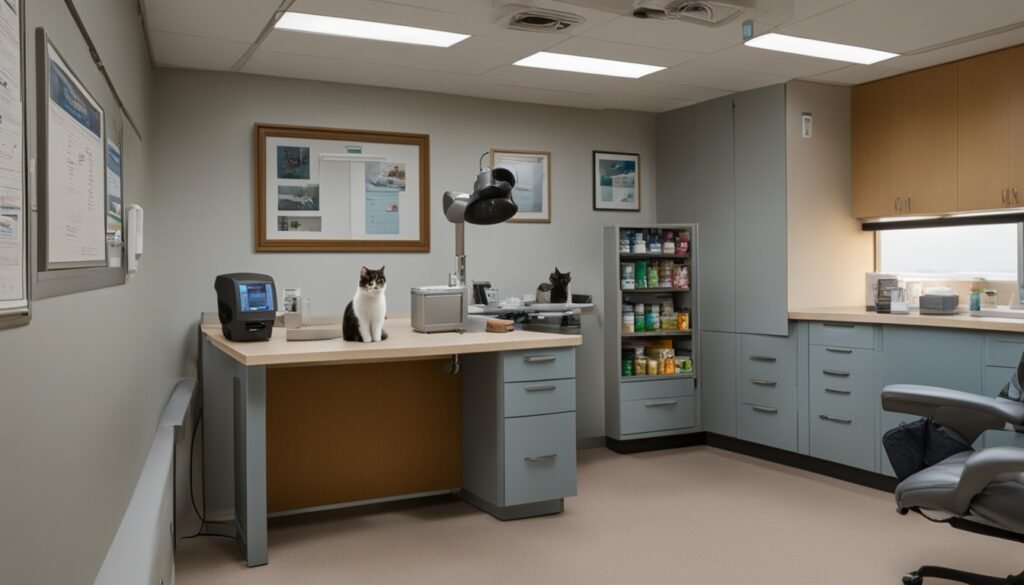
Grooming Routines for a Fabulous Feline
As a devoted cat owner, I know grooming is key for your cat’s health and happiness. Regular grooming keeps your pet’s coat shiny and soft. It also helps manage shedding and prevent hairballs. Here, I’ll share my top tips for a grooming routine that keeps your cat looking and feeling great.
Brushing Basics: Keeping Shedding at Bay
Brushing your cat’s coat regularly is a great way to manage shedding and keep it healthy. Try to brush your cat once a week with a soft-bristle brush made for cats. Start by brushing in the direction of hair growth, being gentle to avoid pulling or tugging. This removes loose hair and spreads natural oils, keeping the coat shiny.
For cats that shed a lot or have long coats, consider a deshedding tool. These tools remove undercoat hair, reducing shedding and keeping your home cleaner.
Nail Trimming: A Delicate Art
Keeping your cat’s nails trimmed is crucial. Long nails can catch on things and cause your cat pain. Trimming nails every 2-4 weeks is key for their comfort.
Use sharp, pet-specific nail clippers and be patient when trimming. Hold your cat’s paw gently and trim the nail tips carefully, avoiding the quick. If you’re unsure, let a vet or professional groomer do it.
Regular grooming, including brushing and nail trimming, is vital for your cat’s care. Adding these routines to your pet’s daily life keeps them looking and feeling their best.

Behavior Training: Fostering a Well-Mannered Companion
Effective behavior training turns your cat into a well-adjusted and delightful companion. It helps solve common issues like scratching and litter box problems. This strengthens your bond with your cat and promotes good manners.
Positive reinforcement is key in behavior training. Reward your cat for good behavior to make them do it more. You can use treats, playtime, or affection to encourage them.
- Establish a consistent training routine to help your cat learn and retain desired behaviors.
- Use interactive toys and puzzles to provide mental stimulation and discourage unwanted behaviors.
- Consult with a professional trainer or veterinarian if you encounter persistent behavioral challenges.
It’s important to address behaviors like scratching or litter box issues. Provide scratching posts and a clean litter box to redirect their natural instincts. This prevents damage to your belongings.
| Behavior Training Tips | Benefits |
|---|---|
| Positive Reinforcement | Encourages desirable behaviors |
| Consistent Routine | Helps cats learn and retain training |
| Interactive Toys and Puzzles | Provides mental stimulation and discourages unwanted behaviors |
| Consulting Professionals | Helpful for persistent behavioral challenges |
Using these behavior training tips will help you have a well-mannered and delightful cat. Remember, be patient and consistent with cats. With the right approach, you’ll enjoy a harmonious relationship with your pet.

Indoor Cat Enrichment: A Stimulating Environment
As a devoted pet parent, I know how key it is to give your indoor cat a fun and engaging space. Indoor cats need us to make a space that meets their needs for activity, thinking, and exploring. By making a play area for cats and adding fun activities, we can stop boredom and keep our cats happy and healthy.
Crafting a Cat-Friendly Play Space
Begin by picking a spot in your home for your cat to play. This could be a cat tree, a wall perch, or a cozy spot with toys and scratching posts. Cats love to climb and look over their territory from high up. Adding shelves, window perches, and cat trees lets them do this and feel safe.
Use pet care tips to keep your indoor cat enrichment fun and changing. Change toys often, add new scratching spots, and try puzzle feeders or toys that make them work for treats.
Mental Stimulation: Keeping Boredom at Bay
Physical play is key, but mental play is just as important for indoor cats. Play with your cat using wand toys, laser pointers, or even cardboard boxes and bags. Watch what they like and play in ways that match their personality and interests.
Short training sessions every day can also keep your cat’s mind sharp. Teach them simple commands or tricks and give them treats for trying. This keeps their mind busy and makes your bond stronger.
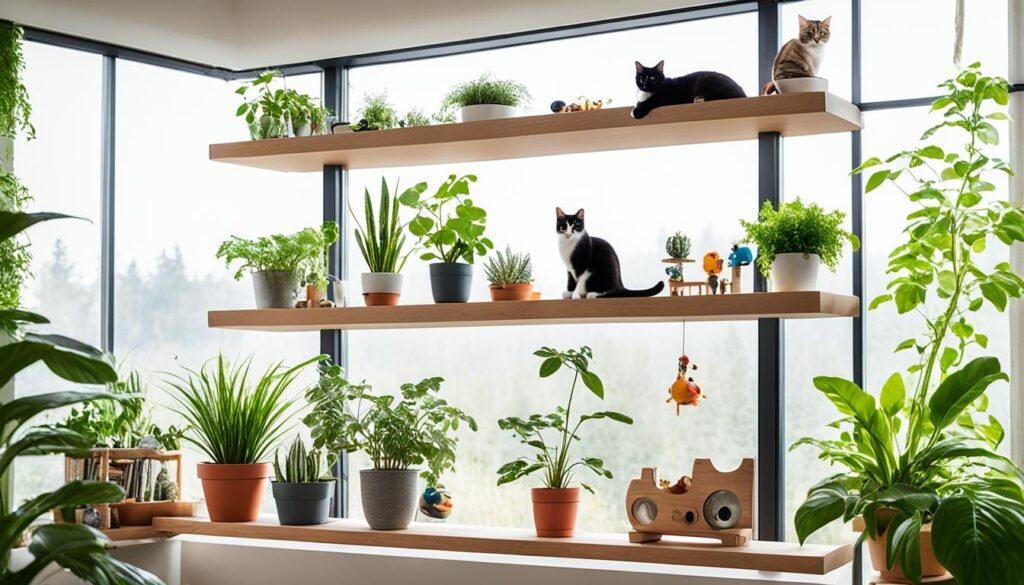
By making a fun space and meeting your indoor cat’s needs, you can make sure they’re happy, healthy, and well-adjusted. With some creativity and a commitment to pet care tips, you can turn your home into a place your cat loves.
Senior Cat Needs: Graceful Aging for Your Feline Friend
As our beloved cats get older, their needs change a lot. It’s important to meet the special needs of senior cats for their golden years to be happy and comfortable. Here, I’ll share tips and insights to help your cat age gracefully.
Dietary Adjustments for Aging Cats
Senior cats need different food than younger ones. They often need more protein and fewer calories to keep muscles strong and manage weight. Giving them high-quality senior cat food can help with their health.
Increased Veterinary Care
Senior cats should see the vet more often. Annual check-ups can catch health issues early, like arthritis or kidney disease. Your vet can give advice on how to care for these issues and keep your cat comfortable.
Environmental Modifications for Aging Felines
Changing your cat’s living space can make a big difference as they age. This means putting litter boxes and food on different levels and using soft surfaces to ease joint pain. Also, playing gently and keeping their minds active is good for them.
By focusing on senior cats’ needs, you can help them age gracefully. Adding these tips to your routine will make your cat healthier and happier.
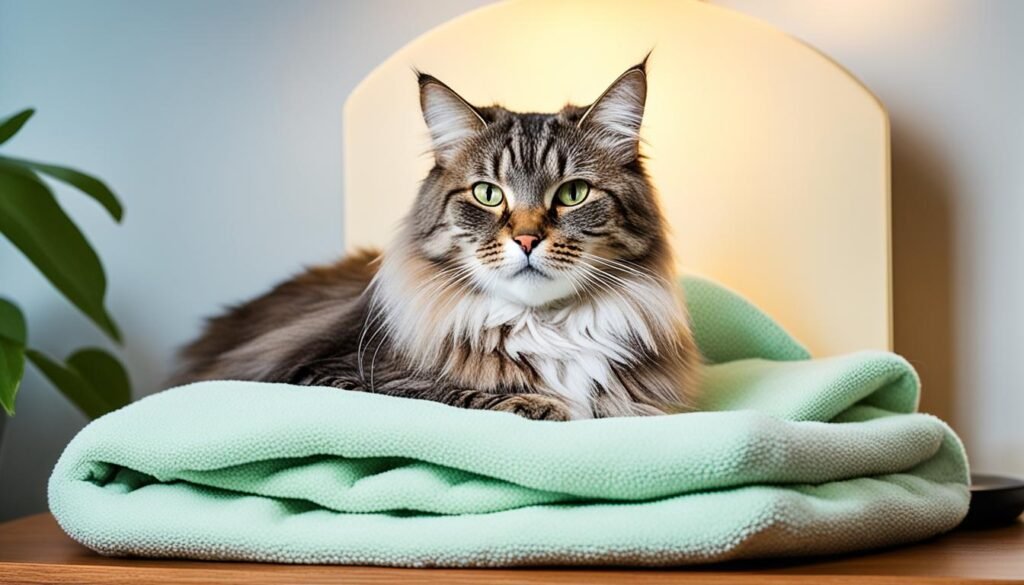
| Senior Cat Need | Recommended Solution |
|---|---|
| Dietary Adjustments | High-quality senior cat food with increased protein and reduced calories |
| Veterinary Care | Annual wellness exams and personalized management of age-related conditions |
| Environmental Modifications | Accessible resources, soft surfaces, and gentle playtime/mental stimulation |
Cat Healthy: A Holistic Approach to Feline Wellness
Keeping your cat healthy means looking at the whole picture. As a pet owner, you need to mix different types of care. This includes good food, regular vet visits, grooming, and making a fun home for your cat. Each part is key to keeping your cat happy and healthy.
Good food is the base of a cat’s health. Picking the right food that fits your cat’s needs is important. Adding superfoods to their meals gives them extra vitamins and minerals.
Seeing the vet regularly is also crucial. Things like shots, fighting parasites, and catching diseases early help keep your cat healthy. It’s important to work closely with your vet for the best care.
Grooming does more than make your cat look nice. It helps with shedding and hairballs, and keeps their nails from hurting. This is good for their health.
Also, a fun and interesting home is key for your cat. Playing with them, giving them toys, and making sure they have room to move stops boredom. This keeps them happy and healthy.
By caring for your cat in a complete way, you help them stay healthy and happy for a long time. Remember, a healthy cat is a happy cat!
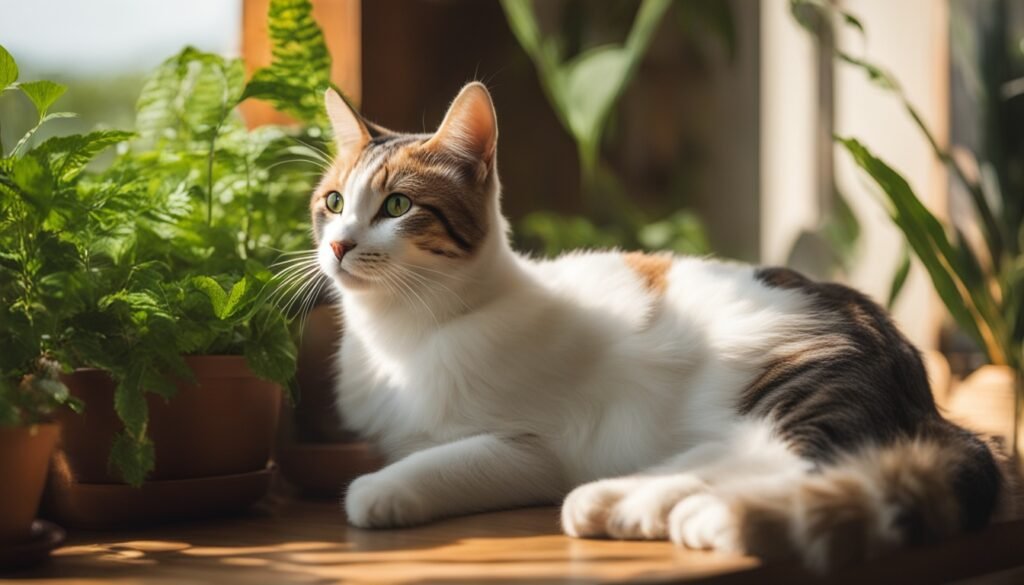
Hairball Prevention: A Furry Predicament Resolved
Hairballs are a common issue for cat owners. But, you can manage this problem with the right approach. We’ll look at dietary solutions and grooming techniques to reduce hairballs. This ensures a cleaner, healthier home for you and your pet.
Dietary Solutions for Hairball Woes
Preventing hairballs often starts with your cat’s diet. A high-fiber diet helps with regular bowel movements and getting rid of ingested fur. Look for cat foods with psyllium husk, beet pulp, or pumpkin.
Adding omega-3 fatty acids to your cat’s diet also helps. It improves skin and coat health, reducing loose fur ingestion. Supplements like fish oil or flaxseed oil are great additions to their meals.
Grooming Tips to Reduce Hairballs
- Brush your cat regularly: Frequent brushing removes loose fur before it’s ingested, reducing hairballs.
- Use a deshedding tool: Tools made for removing excess undercoat are very effective in cutting down on fur shedding.
- Groom your cat after meals: Cats groom more after eating. Brushing them after meals helps prevent hairballs.
By combining a balanced diet with regular grooming, you can tackle hairballs. This keeps your cat happy, healthy, and comfortable.
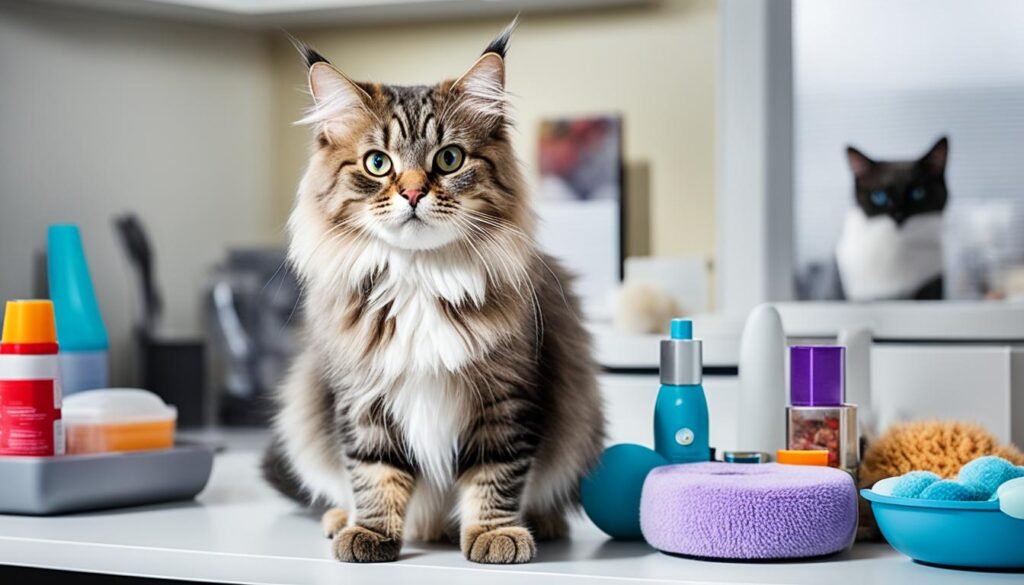
Creating a Stress-Free Environment for Your Cat
Making sure your cat is happy and healthy is very important. It’s key to create a place where they feel safe and calm. By giving them their own space and reducing stress, you help your cat live a peaceful life.
One important thing is to give your cat enough room to be alone. Indoor cat enrichment is crucial. It lets them mark their territory and feel in charge. Give them high places to sleep, like perches or cat trees, where they can be alone and quiet.
Also, following pet care tips like keeping things steady and predictable helps a lot. Don’t change things suddenly and keep their daily routine the same. Pay attention to how they feel and change their space if needed to keep them safe and calm.


